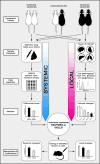A revival of parabiosis in biomedical research
- PMID: 24496774
- PMCID: PMC4082987
- DOI: 10.4414/smw.2014.13914
A revival of parabiosis in biomedical research
Abstract
Modern medicine wields the power to treat large numbers of diseases and injuries most of us would have died from just a hundred years ago, yet many of the most devastating diseases of our time are still untreatable. Chronic conditions of age such as cardiovascular disease, diabetes, osteoarthritis or Alzheimer's disease turn out to be of a complexity that may require transformative ideas and paradigms to understand and treat them. Parabiosis, which is characterised by a shared blood supply between two surgically connected animals, may just provide such a transformative experimental paradigm. Although forgotten and shunned now in many countries, it has contributed to major breakthroughs in tumour biology, endocrinology and transplantation research in the past century. Interestingly, recent studies from the United States and Britain are reporting stunning advances in stem cell biology and tissue regeneration using parabiosis between young and old mice, indicating a possible revival of this paradigm. We review here briefly the history of parabiosis and discuss its utility to study physiological and pathophysiological processes. We argue that parabiosis is a technique that should enjoy wider acceptance and application, and that policies should be revisited to allow its use in biomedical research.
Figures



Similar articles
-
Parabiosis modeling: protocol, application and perspectives.Zool Res. 2021 May 18;42(3):253-261. doi: 10.24272/j.issn.2095-8137.2020.368. Zool Res. 2021. PMID: 33723928 Free PMC article. Review.
-
Heterochronic parabiosis: historical perspective and methodological considerations for studies of aging and longevity.Aging Cell. 2013 Jun;12(3):525-30. doi: 10.1111/acel.12065. Epub 2013 Apr 10. Aging Cell. 2013. PMID: 23489470 Free PMC article. Review.
-
Heterochronic parabiosis for the study of the effects of aging on stem cells and their niches.Cell Cycle. 2012 Jun 15;11(12):2260-7. doi: 10.4161/cc.20437. Epub 2012 Jun 15. Cell Cycle. 2012. PMID: 22617385 Free PMC article. Review.
-
The Effects of Parabiosis on Aging and Age-Related Diseases.Adv Exp Med Biol. 2020;1260:107-122. doi: 10.1007/978-3-030-42667-5_5. Adv Exp Med Biol. 2020. PMID: 32304032 Review.
-
Research Techniques Made Simple: Parabiosis to Elucidate Humoral Factors in Skin Biology.J Invest Dermatol. 2019 Jun;139(6):1208-1213.e1. doi: 10.1016/j.jid.2019.03.1134. J Invest Dermatol. 2019. PMID: 31126426 Free PMC article.
Cited by
-
Endogenous Stem Cells in Homeostasis and Aging.Tissue Eng Regen Med. 2017 Nov 20;14(6):679-698. doi: 10.1007/s13770-017-0097-3. eCollection 2017 Dec. Tissue Eng Regen Med. 2017. PMID: 30603520 Free PMC article.
-
Measuring biological age using omics data.Nat Rev Genet. 2022 Dec;23(12):715-727. doi: 10.1038/s41576-022-00511-7. Epub 2022 Jun 17. Nat Rev Genet. 2022. PMID: 35715611 Free PMC article. Review.
-
Antiaging Therapies, Cognitive Impairment, and Dementia.J Gerontol A Biol Sci Med Sci. 2020 Sep 16;75(9):1643-1652. doi: 10.1093/gerona/glz135. J Gerontol A Biol Sci Med Sci. 2020. PMID: 31125402 Free PMC article. Review.
-
Systemic milieu and age-related deterioration.Geroscience. 2019 Jun;41(3):275-284. doi: 10.1007/s11357-019-00075-1. Epub 2019 May 31. Geroscience. 2019. PMID: 31152364 Free PMC article. Review.
-
dCubilin- or dAMN-mediated protein reabsorption in Drosophila nephrocytes modulates longevity.Dis Model Mech. 2021 Sep 1;14(9):dmm047464. doi: 10.1242/dmm.047464. Epub 2021 Sep 21. Dis Model Mech. 2021. PMID: 34437681 Free PMC article.
References
-
- Edmonds LD, Layde PM. Conjoined twins in the united states, 1970–1977. Teratology. 1982 Jun;25(3):301–8. - PubMed
-
- Spencer R. Anatomic description of conjoined twins: a plea for standardized terminology. J Pediatr Surg. 1996 Jul;31(7):941–4. - PubMed
-
- Demy DL, Ranta Z, Giorgi J-M, Gonzalez M, Herbomel P, Kissa K. Generating parabiotic zebrafish embryos for cell migration and homing studies. Nat Meth. 2013 Mar;10(3):256–8. - PubMed
Publication types
MeSH terms
Grants and funding
LinkOut - more resources
Full Text Sources
Other Literature Sources
Medical
Miscellaneous

